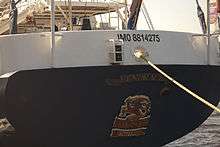IMO number
The International Maritime Organization (IMO) number is a unique identifier for ships, registered ship owners and management companies. IMO numbers were introduced to improve maritime safety and security and to reduce maritime fraud. They consist of the three letters "IMO" followed by unique seven-digit numbers, assigned under the International Convention for the Safety of Life at Sea (SOLAS).[1][2]

The IMO number scheme has been mandatory for all ships since 1 January 1996. The number identifies a ship and does not change when the ship's owner, country of registry or name changes. The ship's certificates must also bear the IMO number. Since 1 July 2004, passenger ships are also required to carry the marking on a horizontal surface visible from the air.[1]
History
IMO resolution (1987)
In 1987 the IMO adopted resolution A.600(15) to create the IMO number scheme aimed at the "enhancement of maritime safety and pollution prevention and the prevention of maritime fraud" by assigning to each ship a unique permanent identification number.[3] The IMO number remains linked to the hull of a ship for its lifetime, regardless of changes of names, flags, or owners. Lloyd's Register had already introduced permanent numbers for all the ships in their published register in 1963, and these were modified to 7-digit numbers in 1969.[4] It is this number series that was adopted as the basis for IMO numbers in 1987.[1]
SOLAS regulation (1994)
SOLAS regulation XI/3 was adopted in 1994 and came into force on 1 January 1996, making IMO numbers mandatory. It was applied to cargo vessels that are at least 300 gross tons (gt) and passenger vessels of at least 100 gt.[1]
In the SOLAS Convention, "cargo ships" means "ships which are not passenger ships".[5] The IMO scheme does not apply to:[1]
- vessels solely engaged in fishing
- ships without mechanical means of propulsion
- pleasure yachts
- ships engaged on special service (e.g. lightships, SAR vessels)
- hopper barges
- hydrofoils, air cushion vehicles
- floating docks and structures classified in a similar manner
- ships of war and troopships
- wooden ships.
Security enhancements 2002
In December 2002, the Diplomatic Conference on Maritime Security adopted a number of measures aimed at enhancing security of ships and port facilities. This included a modification to SOLAS Regulation XI-1/3 to require the IMO numbers to be permanently marked in a visible place either on the ship's hull or superstructure as well as internally and on the ship's certificates. Passenger ships should also carry the marking on a horizontal surface visible from the air.[1] The enhanced regulations came into effect on 1 July 2004.
Company and Registered Owner Regulation 2005
In May 2005, IMO adopted a new SOLAS regulation XI-1/3-1 on the mandatory company and registered owner identification number scheme, with entry into force on 1 January 2009.[6]
The regulation provides that every ship owner and management company shall have a unique identification number. Other amendments require these numbers to be added to the relevant certificates and documents in the International Safety Management Code (ISM) and the International Ship and Port Facility Security Code (ISPS).[1] Like the IMO ship identification number, the company identification number is a seven-digit number with the prefix IMO. For example, for the ship Atlantic Star (IMO 8024026), IMO 5304986 referred to the former ship manager Pullmantur Cruises Ship Management Ltd and IMO 5364264 to her former owner, Pullmantur Cruises Empress Ltd.[7]
Assignment
IHS Maritime is the manager of the scheme and, as such, identifies and assigns IMO numbers without charge.[1] The organization was previously known as Lloyd's Register-Fairplay and IHS Fairplay.
For new vessels, the IMO number is assigned to a hull during construction, generally upon keel laying. Many vessels which fall outside the mandatory requirements of SOLAS have numbers allocated by Lloyd's Register or IHS Markit in the same numerical series, including fishing vessels[8] and commercial yachts.
Structure
An IMO number is made of the three letters "IMO" followed by a seven-digit number. This consists of a six-digit sequential unique number followed by a check digit. The integrity of an IMO number can be verified using its check digit. This is done by multiplying each of the first six digits by a factor of 2 to 7 corresponding to their position from right to left. The rightmost digit of this sum is the check digit. For example, for IMO 9074729: (9×7) + (0×6) + (7×5) + (4×4) + (7×3) + (2×2) = 139.[9][10]
See also
- ENI number, a comparable system for European barges and other inland waterway vessels
- Maritime Mobile Service Identity (MMSI), 9-digit numbers identifying mobile radio stations, used alongside IMO numbers
References
- "IMO identification number scheme". International Maritime Organization. Retrieved 14 July 2017.
- "Implementation of resolution A.1078(28) - IMO ship identification number scheme" (PDF). Letter to All IMO Member States. International Maritime Organization. 8 August 2016. Circular Letter No.1886/Rev.6.CS1 maint: others (link)
- "Resolution A.600(15): IMO Ship Identification Number Scheme". Resolutions and Other Decisions (Resolutions 596 - 635): Assembly, Fifteenth Session, 9-20 November 1987. International Maritime Organization. 1988. pp. 17–20. ISBN 92-801-1234-1.
- "Infosheet No. 45: Lloyd's Register/International Maritime Organisation Numbers" (PDF). Lloyd's Register. 11 July 2012. Retrieved 20 March 2013.
- "Amendments to SOLAS Conventions" (PDF). Class NK. Archived from the original (PDF) on 26 July 2014. Retrieved 20 March 2013.
- "IMO International Convention Calendar". Class NK. 25 December 2012. Archived from the original on 3 March 2014. Retrieved 20 March 2013.
- "Atlantic Star (8024026)". Equasis. French Ministry for Transport. Retrieved 20 March 2013.
- "Unique Vessel Identifier (UVI) - Global Record". Food and Agriculture Organization of the United Nations. Retrieved 20 March 2013.
- Vuori, Teppo (21 August 2013). "How to compute check characters for Coden and IMO Number". Teppovuori.fi. Retrieved 20 September 2013.
- "Error messages table". LRIT DB User Manual. European Maritime Safety Agency. Retrieved 20 March 2013.
External links
| Wikimedia Commons has media related to Ships by IMO number. |